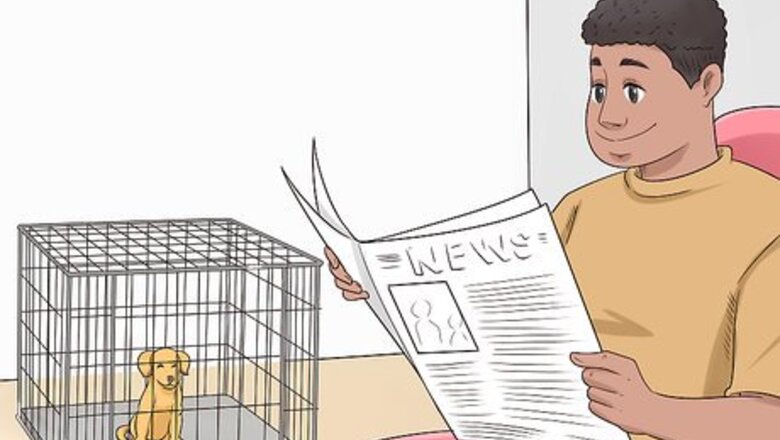
views
- Place your crate in a busy area of your home and introduce your puppy to it using a gentle voice. Keep the crate door open so your puppy feels welcome to explore.
- Tell your puppy to lie down once they enter the crate and close the door behind them. While your puppy is in their crate, they should be relaxed, not up and active.
- After spending time away from your crated puppy, sit quietly nearby for a few minutes before releasing your puppy. This teaches them not to beg and whine when they see you.
Adhering to General Rules
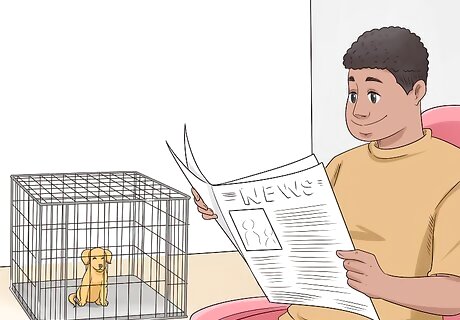
Crate your puppy throughout the day. Don’t only crate your puppy when you’re headed out. Crating your puppy while you’re home will help it feel safe and secure. If you’re always gone when your puppy is in its crate, it could lead to feelings of abandonment. These feelings might make your puppy reluctant to use the crate.
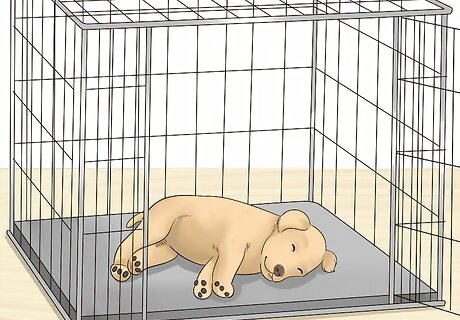
Get a crate that allows your puppy to lie on its side with its legs outstretched, turn around easily, and stand up in its crate without hunching. If your puppy can walk around in circles in its crate, the crate is too large. Another sign that the crate is sized improperly is that your puppy can go to the bathroom without then laying in (or right next to) its mess.
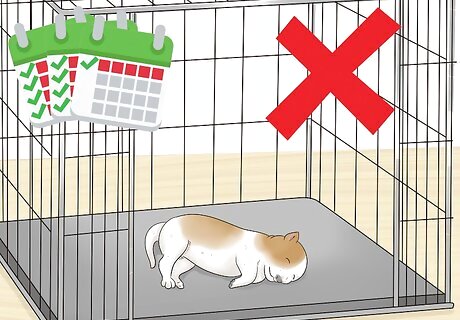
Don’t crate your puppy before it is nine weeks old. Puppies that are too young have trouble learning and exercising self-control. While you could obtain the crate and allow your puppy to interact with it before it is nine weeks old, the actual training process should not begin until it is at least nine weeks old.
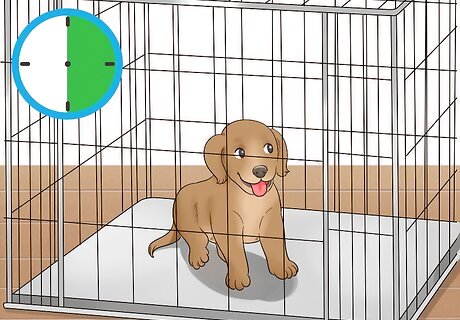
Limit the amount of time your puppy spends in its crate based on its age. The amount of time that you can safely leave your puppy in its crate depends on how good your puppy is at holding its bladder. The younger the puppy is, the more often it will need to relieve itself. If your pup is about 10 weeks old, it should spend no more than 30-60 minutes in its crate. If your pup is 11-14 weeks old, it won’t be able to spend more than one to three hours in its crate. A puppy aged 15-16 weeks old should not spend more than three to four hours in its cage. When your sweet puppy turns 17 weeks old, it should be able to spend about four to five hours in its crate. Never leave a puppy in its crate all day.
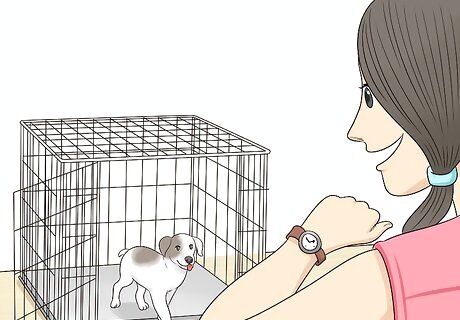
Step away to check on your puppy based on how long you need to keep it confined. For example, if your puppy is scheduled to spend three hours in its cage, return at the three-hour mark to let it out. You might have to change your schedule in order to continue crate-training your puppy.
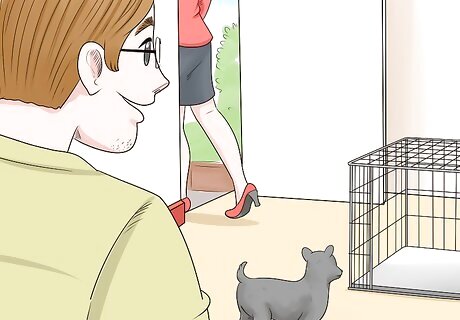
Get help if you need it. Crate-training a puppy can be challenging if you have to go to work or have other obligations. If necessary, ask a friend or relative to help you crate-train your puppy when you’re not around and unable to return. If nobody is available, hire a dog-sitter to help you.
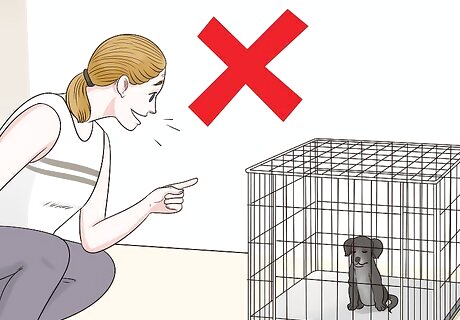
Don’t use the crate as punishment. If you use the crate as a place where your dog goes when it is in trouble, it will begin to think of the crate as a bad place. In order to maintain your dog’s positive attitude toward the crate, only send your dog to its crate when necessary.
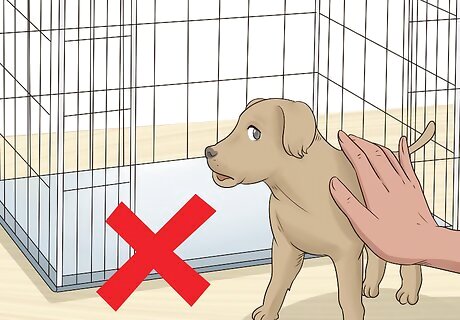
Don’t push your puppy into the crate. If you force your puppy into its crate, it will not experience the crate as a place of safety and happiness. Instead, your puppy will think of the crate as a scary place, which will make crate-training much harder.
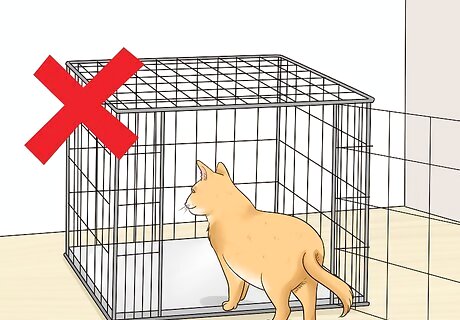
Don’t let any people or pets in the crate. If you have other cats or dogs, don’t let them in your puppy’s crate. The scent of these other creatures might make your puppy feel that the crate is not really theirs. For the same reason, don’t let your small children play in your dog’s crate.
Introducing the Dog to the Crate

Place the crate in a busy area of the house. If your crate is tucked away in a closet or on a shelf, your puppy will never go in it. To familiarize your puppy with the crate, place it in the living room or in a large bedroom where your puppy spends a lot of time.
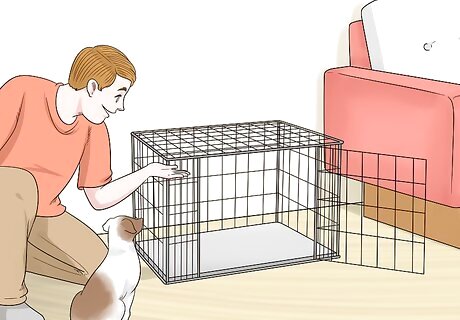
Show the crate to your puppy. After placing the crate in a central location, tell your puppy, “Here is your crate” in a kind and gentle voice. Keep the door of the crate open so that your puppy feels welcome to explore it.
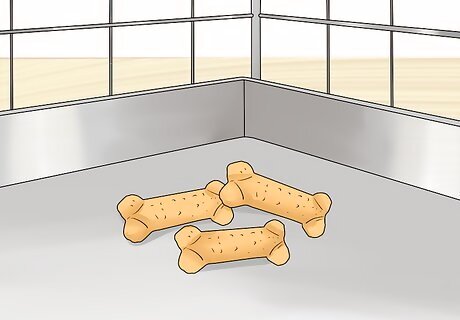
Place some treats in the crate. Your puppy will probably want to satisfy its natural curiosity by exploring the crate whether there are treats in it or not. But to make the experience even more welcoming, place a few treats in the crate. This will make the new crate irresistible and help your puppy get used to being in and around it. If your dog is reluctant to enter the crate even when treats are inside, place the treats outside the crate at first. Gradually move the treats closer until they are just barely inside the crate. Then, start placing them against the back wall of the crate. Repeat for the duration of the crate-training process.
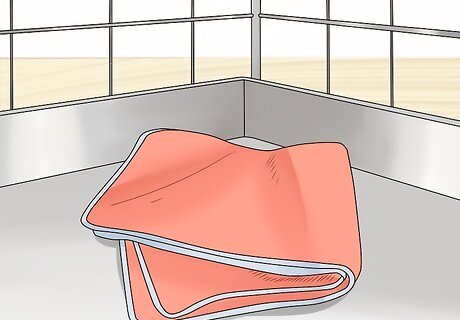
Place a comforting object in the crate. Place an object that your puppy associates with comfort, such as its favorite toy or a blanket that smells like its mother or you, into its crate. This may give your puppy good feelings and also help your puppy to think of its crate as a positive, comforting place.
Getting Your Dog Used to the Crate
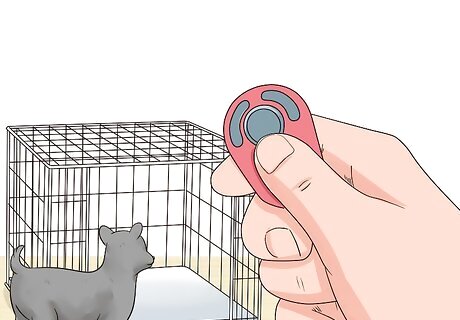
Use a clicker and reward system when your puppy pays attention to the crate. In addition to treats and toys in the crate itself, reward your puppy when it interacts with the crate in any way. For instance, if your puppy looks at the crate, click your clicker and give it a treat. Click your clicker and give your puppy a treat when it moves toward the crate. If your puppy puts any or all of its paws in the crate, click your clicker and give your puppy a treat.
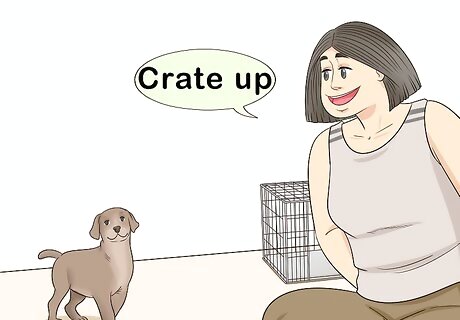
Teach your puppy a cue word. The cue word is the word or phrase that you’ll use when you want your puppy to go into its cage. Start saying your cue word when your puppy gets in its crate. Then, click your clicker and give your pup a treat. For instance, you might say the word “Crate” or the phrase “Crate up” when you want your dog to go in its crate. Continue using the cue word until your puppy has completed its crate-training. This will help your puppy develop the association between the cue word and the action of getting in its crate.
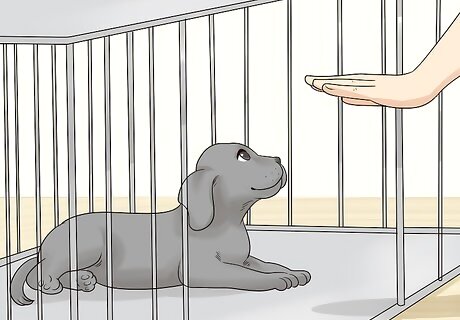
Command your puppy to lie down. While your puppy is in its crate, it should be relaxed, not up and active. To help your puppy adopt the right behavior while in its crate, have it lie down after it enters the crate from this point on. Click your clicker and reward your dog when it enters the crate and lies down.
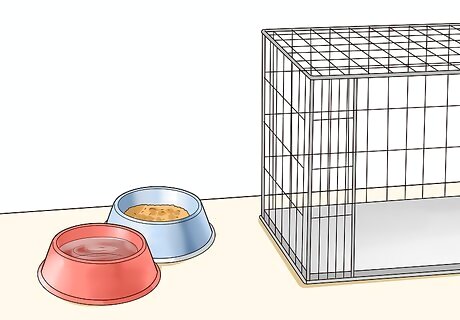
Place food and water bowls near the crate. If your puppy is still not enjoying treats and retrieving toys from its crate after several days, begin moving its dishes nearer to the crate. This will prepare your dog to eat its meals inside the crate. Continue this process for three or four days.
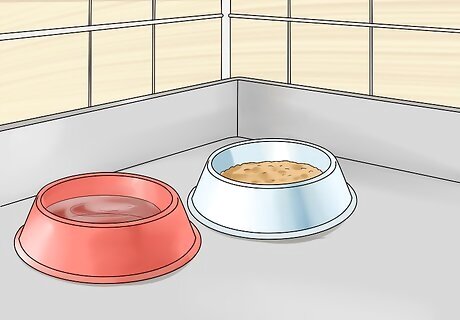
Put the food and water bowls inside your dog’s crate. After your puppy happily takes treats and toys from the inside of its crate (or after your puppy eats from its food bowls near the crate), move the food bowls just slightly inside the threshold of the crate. Gradually move the dishes toward the back wall of the crate over the course of several days. Every meal from now until crate-training is complete should be served in your furry friend’s crate.
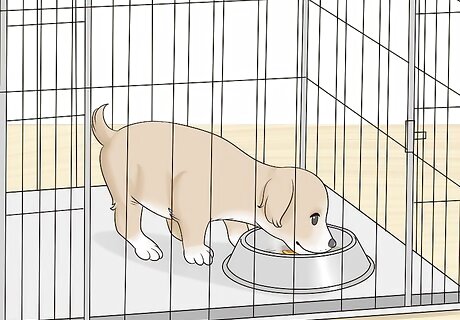
Close the door on your puppy’s crate while it is eating. This will help your pup get used to being in the crate with the door closed. Open the door when your puppy has finished eating.
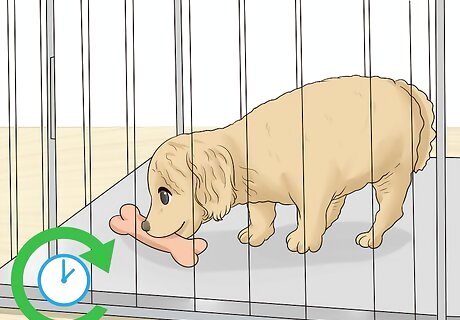
Gradually leave the door closed for longer periods. Each time your puppy eats in its crate with the door closed, add several seconds to the period between the end of its meal and the time you let it leave the cage. Continue until your puppy can stay in its crate with the door closed for up to 10 minutes. There is no one “right” interval by which you should increase the amount of time your puppy spends in its crate during daytime crate-training. For instance, you could add three seconds or four seconds to the amount of time your puppy spends in its cage after each meal. However, if your puppy starts whining after it finishes eating with the door to the crate closed, you might have added too much time. Roll back the amount of time your puppy spends in its crate with the door closed, then start adding time again in smaller intervals.
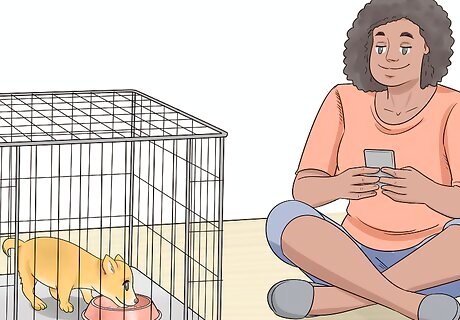
Remain near the crate when your puppy is inside. Once your puppy knows its cue word, can eat in its cage, and can remain there for about 10 minutes or so, command it to go in its cage. Close the door and wait with your pup for five to 10 minutes. You should not interact with your puppy during this time.
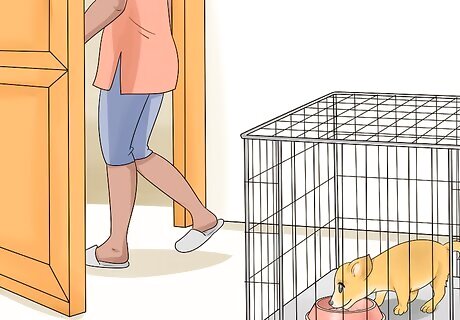
Go into another room for a few minutes. After sitting near your puppy quietly for a few minutes, head out for about five minutes. This will help the puppy get used to the idea that sometimes you will not be around when it is in its crate. Gradually extend the time you spend out of sight until your puppy is spending 20 to 25 minutes in its cage without you around.
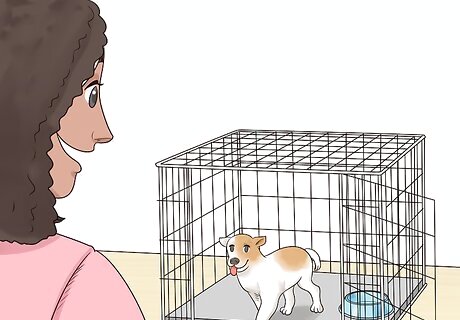
Return and let your puppy out of its crate. After spending some time away from your crated puppy, come back and sit quietly nearby for another five minutes or so. Then, open the door to your puppy’s crate. This will teach your puppy not to beg and whine for its crate to be opened when it sees you. Don’t let your puppy out if it’s actively whining, as this teaches your puppy that whining gets it released. Instead, wait a moment for the puppy to stop whining and settle down, and then open the door. This will show your puppy that calm behavior is rewarded.


















Comments
0 comment